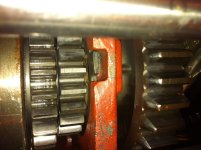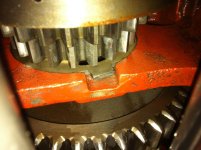I can't locate the crack in the second photo. Is it in the same place? I'm guessing it would be as that appears to be where the material is the thinnest even though they put a bulge in the casting to help overcome the slot.
The left side doesn't look all that thick. Without 360 degrees of support one wonders how long it will be before the left side cracks also and the whole shebang fails. I know cast metals will fail under repeated impacts but this is smooth-fairly constant radial stress which isn't the same critter.
Questions that would be nice to know would be how many hours are on both housings and when did each crack. Knowing that might provide your answer.
I did a www search on "yield pressures for cast iron" and came upon at least one interesting article:
http://fulltorque.com/pdf/GMRC white paper.pdf
Might want to read it. One thing it did point out that I suspected was stresses on the casting were relieved in the crack. On your application, with stresses relieved and the radial stresses on what's left not exceeding the yield point of the remaining bracket you may be good to go.
Tough call.
Edit: Surely you have heard of "green castings" and stresses associated. The mentality here is that a "seasoned" casting usually has the stresses stabilized whereas the green casting has to go through the "sweat". I think your answer is in finding the yield point of cast iron and once you have that number, try to find out what the lateral stresses are on the bracket caused by the gears interfacing and pushing away from each other. Being on the input shaft to the tranny, you have no reduction so if your tractor is putting out 123 ft lbs of torque at the flywheel at WOT then surely not more than 10% of that would be in lateral stress and removing the feet you have lbs of force pushing against the casting.
I don't have the number in front of me but suppose your tractor engine is rated 100 ft-lbs of torque on a dyno. at rated rpms. With no feet and pushing on one square inch of casting, taking 10% would be 10 psi of force. Sounds like a no brainer. Even if it were the whole 100 on 1 square inch you are still at 100 psi. On the same Google site I found another entry and it talked about Grey Iron, Class 20 as an example at 20,000 psi yield strength. So one can assume that a Class 1 will be at least 1000 psi.
The more I mull over this the more comfortable "I" would be with moving right along with your repair and to not worry about it. Besides if you were to tear one up you have the other as a backup to decide what you want to do.
Best I can do,
Mark

